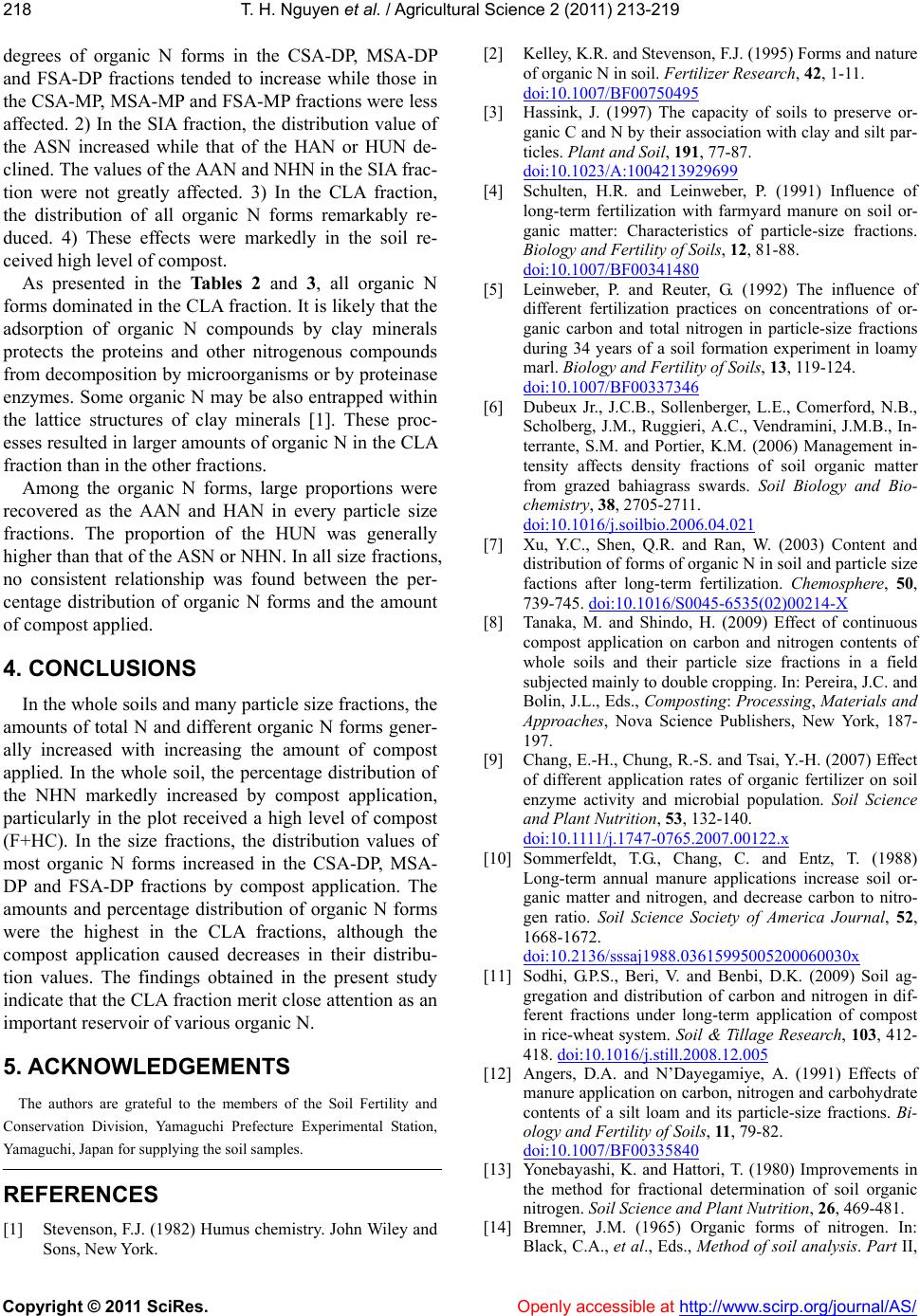
T. H. Nguyen et al. / Agricultural Science 2 (2 011) 213-219
Copyright © 2011 SciRes. Openly accessible at http://www.scirp.org/journal/AS/
218
degrees of organic N forms in the CSA-DP, MSA-DP
and FSA-DP fractions tended to increase while those in
the CSA-MP, MSA-MP and FSA-MP fractions were less
affected. 2) In the SIA fraction, the distribution value of
the ASN increased while that of the HAN or HUN de-
clined. The values of the AAN and NHN in the SIA frac-
tion were not greatly affected. 3) In the CLA fraction,
the distribution of all organic N forms remarkably re-
duced. 4) These effects were markedly in the soil re-
ceived high level of compost.
As presented in the Tables 2 and 3, all organic N
forms dominated in the CLA fraction. It is likely that the
adsorption of organic N compounds by clay minerals
protects the proteins and other nitrogenous compounds
from decomposition by microorganisms or by proteinase
enzymes. Some organic N may be also entrapped within
the lattice structures of clay minerals [1]. These proc-
esses resulted in larger amounts of organic N in the CLA
fraction than in the other fractions.
Among the organic N forms, large proportions were
recovered as the AAN and HAN in every particle size
fractions. The proportion of the HUN was generally
higher than that of the ASN or NHN. In all size fractions,
no consistent relationship was found between the per-
centage distribution of organic N forms and the amount
of compost applied.
4. CONCLUSIONS
In the whole soils and many particle size fractions, the
amounts of total N and different organic N forms gener-
ally increased with increasing the amount of compost
applied. In the whole soil, the percentage distribution of
the NHN markedly increased by compost application,
particularly in the plot received a high level of compost
(F+HC). In the size fractions, the distribution values of
most organic N forms increased in the CSA-DP, MSA-
DP and FSA-DP fractions by compost application. The
amounts and percentage distribution of organic N forms
were the highest in the CLA fractions, although the
compost application caused decreases in their distribu-
tion values. The findings obtained in the present study
indicate that the CLA fraction merit close attention as an
important reservoir of various organic N.
5. ACKNOWLEDGEMENTS
The authors are grateful to the members of the Soil Fertility and
Conservation Division, Yamaguchi Prefecture Experimental Station,
Yamaguchi, Japan for supplying the soil samples.
REFERENCES
[1] Stevenson, F.J. (1982) Humus chemistry. John Wiley and
Sons, New York.
[2] Kelley, K.R. and Stevenson, F.J. (1995) Forms and nature
of organic N in soil. Fertilizer Research, 42, 1-11.
doi:10.1007/BF00750495
[3] Hassink, J. (1997) The capacity of soils to preserve or-
ganic C and N by their association with clay and silt par-
ticles. Plant and Soil, 191, 77-87.
doi:10.1023/A:1004213929699
[4] Schulten, H.R. and Leinweber, P. (1991) Influence of
long-term fertilization with farmyard manure on soil or-
ganic matter: Characteristics of particle-size fractions.
Biology and Fertility of Soils, 12, 81-88.
doi:10.1007/BF00341480
[5] Leinweber, P. and Reuter, G. (1992) The influence of
different fertilization practices on concentrations of or-
ganic carbon and total nitrogen in particle-size fractions
during 34 years of a soil formation experiment in loamy
marl. Biology and Fertility of Soils, 13, 119-124.
doi:10.1007/BF00337346
[6] Dubeux Jr., J.C.B., Sollenberger, L.E., Comerford, N.B.,
Scholberg, J.M., Ruggieri, A.C., Vendramini, J.M.B., In-
terrante, S.M. and Portier, K.M. (2006) Management in-
tensity affects density fractions of soil organic matter
from grazed bahiagrass swards. Soil Biology and Bio-
chemistry, 38, 2705-2711.
doi:10.1016/j.soilbio.2006.04.021
[7] Xu, Y.C., Shen, Q.R. and Ran, W. (2003) Content and
distribution of forms of organic N in soil and particle size
factions after long-term fertilization. Chemosphere, 50,
739-745. doi:10.1016/S0045-6535(02)00214-X
[8] Tanaka, M. and Shindo, H. (2009) Effect of continuous
compost application on carbon and nitrogen contents of
whole soils and their particle size fractions in a field
subjected mainly to double cropping. In: Pereira, J.C. and
Bolin, J.L., Eds., Composting: Processing, Materials and
Approaches, Nova Science Publishers, New York, 187-
197.
[9] Chang, E.-H., Chung, R.-S. and Tsai, Y.-H. (2007) Effect
of different application rates of organic fertilizer on soil
enzyme activity and microbial population. Soil Science
and Plant Nutrition, 53, 132-140.
doi:10.1111/j.1747-0765.2007.00122.x
[10] Sommerfeldt, T.G., Chang, C. and Entz, T. (1988)
Long-term annual manure applications increase soil or-
ganic matter and nitrogen, and decrease carbon to nitro-
gen ratio. Soil Science Society of America Journal, 52,
1668-1672.
doi:10.2136/sssaj1988.03615995005200060030x
[11] Sodhi, G.P.S., Beri, V. and Benbi, D.K. (2009) Soil ag-
gregation and distribution of carbon and nitrogen in dif-
ferent fractions under long-term application of compost
in rice-wheat system. Soil & Tillage Research, 103, 412-
418. doi:10.1016/j.still.2008.12.005
[12] Angers, D.A. and N’Dayegamiye, A. (1991) Effects of
manure application on carbon, nitrogen and carbohydrate
contents of a silt loam and its particle-size fractions. Bi-
ology and Fertility of Soils, 11, 79-82.
doi:10.1007/BF00335840
[13] Yonebayashi, K. and Hattori, T. (1980) Improvements in
the method for fractional determination of soil organic
nitrogen. Soil Science and Plant Nutrition, 26, 469-481.
[14] Bremner, J.M. (1965) Organic forms of nitrogen. In:
Black, C.A., et al., Eds., Method of soil analysis. Part II,